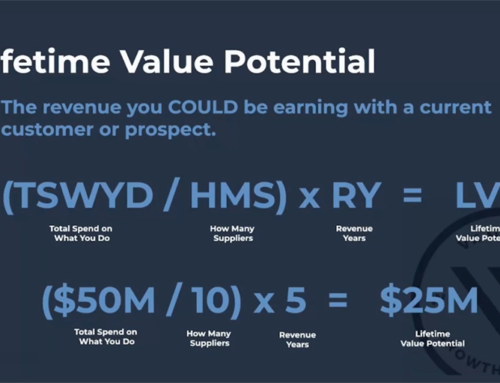Listen to Vx Group President, Eric Zoromski discuss with Eric LaRose, how to develop an Ideal Customer Profile and use it to identify new customers.
When you think about it, there are two kinds of customers, those who buy from you and those who grow with you. Today we’re talking about the latter, specifically how you identify these idea customers, attract them and nurture them.
I think it’s true that a lot of people do believe that any customer is a good customer, but when you look at your customer base and you start to segment it out, you can see which ones are really the ones that are driving your business and which ones are maybe holding your business back or making you invest in resources that you might not otherwise need, if you are really focused on servicing the customers that have the biggest impact on your business.
Full Transcription of “Why an Ideal Customer Profile is Important”
Welcome to Problems Worth Solving. I’m your moderator, Eric Larose. On the show we take a look at a common issue that mid-level manufacturers face on a regular basis, then we dissect them, provide insight on how you can address these challenges and grow your business. I’m joined by The VX Group President, Eric Zoromski, to talk about something we all need; customers, but not just any customers, ideal customers.
When you think about it, there are two kinds of customers, those who buy from you and those who grow with you. Today we’re talking about the latter, specifically how you identify these idea customers, attract them and nurture them.
Eric L: So today we’re talking about ideal customer profiles. The common myth is that anybody who has a cheque that will clear is a good customer but, Eric, as you’ve discovered, this isn’t always the case. What makes an ideal customer?
Eric Z: I think it’s true that a lot of people do believe that any customer is a good customer, but when you look at your customer base and you start to segment it out, you can see which ones are really the ones that are driving your business and which ones are maybe holding your business back or making you invest in resources that you might not otherwise need, if you are really focussed on servicing the customers that have the biggest impact on your business.
Eric L: You actually bring up something that’s interesting there, that customers can actually cost you money, if they’re not ideal customers.
Eric Z: Well, it’s oftentimes that you think you’re making a profit, because you’re selling them a product or a service that hopefully inherently has profit built into it, but unfortunately a lot of time the overhead associated with servicing those customers can quickly eat away at any profit that you might have. Oftentimes customers that don’t fit your ideal customer profile, they may be customers from a smaller revenue perspective, and those might require or demand a higher level of service, so you’re investing a lot to retain a relationship with a small customer that never is going to have the potential to really have a significant impact on your business overall.
Eric L: Now, every business has ideal customers, along with a larger pool of customers who just buy stuff from you. Ideally there’s a ratio of these two customer groups you should be working toward, we’ll talk about that in a second. First, a question for you; How well do you know your sales data? That’s the key, because within that data you can easily see who is a customer and who is an ideal customer.
Eric Z: One of the first things to do, or one of the first-step things to do, is to what we would call 80/20 your customer base. The 80/20 concept is based on the Pareto principle, it’s the idea that in almost anything, 80% of something comes from 20% of something else. So in sales, and when looking at a customer portfolio, when you look at many businesses, 80% or more of their revenue likely comes from approximately 20% of their customer base. While it seems like a very simple concept and one that you go “Oh, that can’t be true”, if you do it on your business, you’re going to find out its probably true. In fact, you’ll probably find out that it’s more like 90/10 or 85/15 than it is 80/20.
Eric L: Is that ratio good, 80/20?
Eric Z: It tells you that 80% of your revenue is coming from 20% of your customers, so if you have a hundred customers, twenty of those are delivering the vast majority of your revenue, the other eighty are probably a distraction to your business and ultimately are taking your eye off of the 20% that are high-performing customers, which increases your risk of potentially losing a customer or not maximising the potential that you might have with them, because you’re dealing with one of the eighty that maybe represents 1% of your revenue. It’s a pain in the ass, they’re screaming, they’re hollering, they’re emailing you about problems, they’re arguing with you about price, they’re questioning delivery, they’re micro-analysing invoices.
Eric L: They need something absolutely right now and you have to stop everything to give them that one thing.
Eric Z: Right, if you’re a manufacturer, that product that you’re running for them may be inhibiting you or preventing you from doing much higher value business. Once you do that 80/20 analysis and you start to look at the 20% or so of your customer base that make up the majority of your revenue, you start to look at them and see the characteristics across that customer base that start to provide the indicators that will help you define who your ideal customer is.
Eric L: And therefore who you should be going after, as an ideal customer.
Eric Z: Right, if you’ve got a sales force out in the field, you want to direct them towards ideal customers and tell them to stop pursuing non-ideal customers, because sales people without direction will chase any shiny object that they see, and that shiny object may be great for the business, at least that’s the hope, but that shiny object may be just another shit-show (for lack of a better term) that gets tossed over the wall into production, and now you’ve got production in turmoil, because they’re dealing with a customer that’s not a good fit, and now you’ve created a distraction and you’re not really maximising the opportunity that you might have by focusing on customers that are a good fit for your business.
Eric L: Right, and when you’ve got those ideal customers, too, that’s a way to grow the company, you’re not making the one sale, you’re actually building a relationship with somebody who’s going to need your products and services more and more and more, as they grow.
Eric Z: I think what people don’t often understand or sometimes overlook is the impact that having a heavily weighted ideal customer portfolio, the positive impact that that can have on the rest of your organisation, from an operational perspective and even from a talent perspective and retention perspective, having a strong focus on building a customer portfolio that’s made up of ideal customers has a positive impact that goes well beyond just revenue and ultimately profitability.
Eric L: So, Identifying your ideal customers is the first step, and while Eric said it’s a relatively simple process, it’s easy to get bogged down with the sheer amount of data you have available to you in your CRM or customer relationship management program. You want to arm your sales staff with the right customers, that meet the criteria of your ideal customer profile, and there’s definitely a profiling process you need to follow to get them that information.
Eric Z: Generally we’ll start with an 80/20 analysis of a company’s current client roster, get a feel for what that looks like, then take a look at the companies that make up the 20% that are driving 80% of the revenue, determine what characteristics there are across those companies that are common, so that could be anything from they’re all in the same revenue range. So one company may be a great fit for companies that are between ten million and two hundred million dollars in revenue, and that’s a number that’s pretty readily available, or at least you can get a good feel for that. Other companies may be a better fit for five hundred million to a billion, or billion-plus type companies, again, a pretty easy number to get at. So that’s an indicator that’s pretty straight-forward, that gives you a feel for the types of companies, and it’s a great illustration of what happens when a company gets out of their ideal customer range, so if a company is built to service mid-market companies, fifty to two hundred million dollar companies, if they get an opportunity with Caterpillar or General Dynamics, chances are they’re going to get really excited about that opportunity, they’re going to go in there with their guns ablaze and when they get in there they’re going to realize their guns are really a cap-gun or a pop-gun and they’re quickly going to find out that the massive overhead required to work with companies of that magnitude are something they’re just not ready for, they’re in over their head. So you can spend a lot of time doing that and you can get a sales group that’s all excited, that “We’re going to go out and get this whale”, and they’re going to find out quickly that the organization’s not ready for that. And you can spend a lot of time and money and travel and energy chasing something that you’re probably not going to win, because you’re just not set up to win. That’s why it’s so important to really know who to go after, it’s not just ones that you think are going to be good for your business, it’s got to be ones that you think you’re going to win, and then that you’re ultimately going to be successful in delivering to.
Eric L: Yes, going after whales is great, but fishing for trout is fun too.
Eric Z: You know, a common analogy is hitting singles versus swinging for the fences, and every organization should do a little bit of both, but they should probably be spending 80% of their time hitting solid singles with customers that they’re well positioned to win the business and deliver on the promises that they make and then, yeah, three or four times a year, swing for the fences and see what happens. None of that is possible if you don’t know who your ideal customer is, because then you’re just swinging in the dark. Once you’ve got you framework for your ideal customer, one of the important next steps is to essentially develop a ranking system for your current customers and then also to be used as a filter for your new customer acquisition efforts. One of the things that we find that the ideal customer profiles become, is truly a filter and they help with the decision making process, so if you, as a leader, if a sales person comes to you and says “I’ve got an opportunity, I’m going to fly to Dallas and meet with this company. Is it ok if I spend fifteen hundred bucks?” If you don’t have an ideal customer profile, you really don’t have the ammunition that you need to make a good decision. You don’t know if the sales person is going there to pursue a customer that may take you five years to make your fifteen hundred dollars back, or whether they’re going there to pursue a customer that could end up in millions of dollars of revenue for years to come. So using the ideal customer profile as a decision making tool, I think, is one of the most enlightening things that I see our customers do. So going through and developing a ranking criteria, or it could be a, b, c customers, whatever you want to call them, you’re going through your existing customer base, whether it’s ten customers or ten thousand customers, giving each of them a grade or a score and then using that information to inform the decisions that you make as far as how you’re going to allocate resources, where are you going to make investments in order to grow, and what are some potential customers of yours that maybe you should encourage to go on to a new partner. One of the things that we’re seeing with one of our customers, is they’re kind of culling the bottom of their customer list, and their customers saying “Wait, wait, wait, we’re actually doing a lot more of this business than we’re giving you and we don’t want to go away, do you want to bid on this?” So now, a customer that they perceived as a low-value customer, really likes working with them and is willing to actually give them more business and work their way up into a b or even an a customer. So just having the dialogue and having the conversation sometimes is enough to move a customer deeper into your organisation and allow you to grow a deeper relationship.






